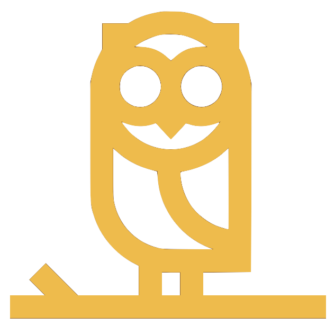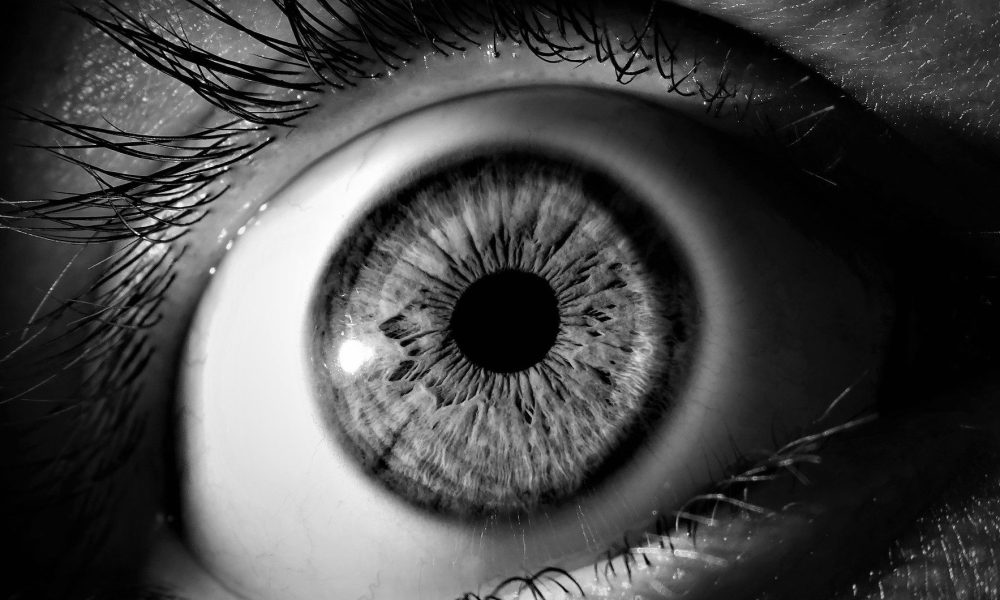The All Seeing Eye symbol is on the great seal of America and features on its dollar bill, surrounded by a Latin inscription with a part that easily reads “New Order”. The symbol is also associated with secret societies such as the Illuminati, a prime subject for conspiracy theories of world control.
America. Money. Latin inscription. Secret society.
All these are a perfect recipe for making the eye symbol a feared one. And it doesn’t help that there’s a trend of celebrity photoshoots with the one-eye symbol.
To many, the All-Seeing Eye is a symbol of power, surveillance and control over the people. However, the reason for using the all-seeing- eye on the dollar bill was to invoke the protection of God over the nation. This practice has existed for thousands of years, in many parts of the world.
So why the fear?
Well, maybe because for thousands of years, the eye has also meant ‘evil’, ‘destruction’ and ‘control’.
In this [essay], we’ll look at the history of the eye symbolism (all-seeing eye, evil eye, third eye) across the world; its meaning of good and evil but also of its root, consciousness. We’ll look at the psychology and philosophy of the eye. What is it about the function of the eye that makes it the advocator of the self. Why is the eye the cosmos that observes itself? Answering these questions will explain why the eye holds so much power over us and why we seek comfort in the eye but fear it at the same time.
Ok let’s start with the
History of the Eye symbol


Ancient Mesopotamia
In ancient Mesopotamia, modern-day Syria, Iraq, Turkey and Kuwait, people worshipped many different gods. There was the god of the sky, of the underworld, the goddess of war and love, to name a few…and these deities were portrayed by clay tablet texts, figurines or cylinder seals.
There were also Eye idols – figurines depicting large round eyes. The eyes varied in style, at times perforated, at times with spectacles, and others in threes or more. Historians found an abundance of these idols when excavating in the Near East, particularly in Tell Brak, an ancient city in Syria, in a religious complex, later labelled as the Eye Temple.
The body of these figurines didn’t seem to be of particular importance as if to bring attention to the eyes only. Scholars say that the people of ancient Mesopotamia believed to be under the constant watch of the gods. That meant that the gods’ eyes were all-seeing and protecting them, but there were also gods with the “evil eye” who would punish them.
The evil eye could belong to any deity, but it has often been associated with Tiamat, the goddess of seawater and primordial creation. Tiamat has also been represented as a gigantic monstrous snake.
Mesopotamians believed that sickness, death or natural disasters were inflicted due to the wrath of the gods. These events arose unexpectedly and this caused them to be in a lot of fear. Their well-being was in the hands of the gods.
It’s understandable why one would often pray, asking the gods for protection. Ancient Mesopotamians would offer sacrificial gifts as they made vows, wishes and bargains with the gods. Offerings were also given as a “thank you” when a favour seemed to have been realized.
Along with the Eye idols, archeologists also found many figurines of what seemed to be worshippers, praying with wide-open eyes. These may have been the votive offerings to the gods; a symbol of being under the care of the god, while expressing “I am aware of your existence. I worship you. You are my god”.
The Eye idols, on the other hand, seemed to symbolize the constant all-seeing divine quality of the god or goddess whose statue would be present in the temple.
The watchful eyes also came in the form of an amulet, to be used as a sort of lucky charm, for protection against the evil eye.
The eye could be reduced to just an eyeball. (This eye stone was dedicated to Marduk, a patron god of the city of Babylon. There’s an inscription inside of it, praying for protection for the king of Babylon)
To the Mesopotamians, the evil eye could be projected by the gods, but also by humans. In fact, they believed that men were the instruments of gods to cause damage to the people; a simple look or stare by a person with ill intent, jealousy or anger could cause harm to a person.
To some of you, this may sound very familiar! We’ll talk about that later, but first, let’s move on to Egypt!
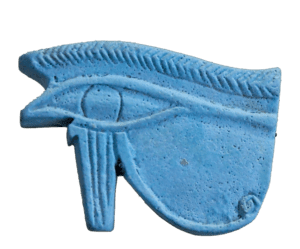

Ancient Egypt
In ancient Egypt, another polytheistic civilization, the eye symbol, known as the Eye of Horus or Wadjet, is one of its most popular symbols.
Horus is the god of the sky and royalty.
One of the many versions of the myth tells how Horus sacrificed his own eye to resurrect his father, Osiris, who was dismembered by his enemy. Horus’s eye, therefore, became the symbol of healing, well-being and protection.
Of course, ancient Egyptians also had eye amulets to protect against evil. The overall Egyptian concept of the eye is very similar to that of the Mesopotamians. There’s a protective eye but there’s also a destructive or “evil” eye. The one difference is that Egyptians see the evil eye as complementary to the protective eye.
This evil eye is the Eye of Ra.
Ra is the Egyptian sun god, the creator god, and his eye is his female counterpart, she could be his sister, wife or daughter. She is his ‘doing’ and his destructive side. When Ra is angry, his eye protects him by the act of destroying.
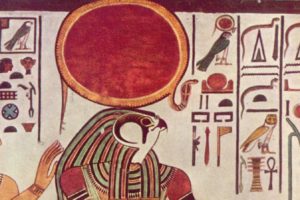

Ra’s eye is also equivalent to the sun disk and can be embodied as a separate female deity, like Hathor or Sekhmet. Again, the female goddess is Ra’s complementary opposite. “Destruction” goes with “creation”.
To the Mesopotamians, these are separate from one another. God is separate from Evil, and Evil is to be feared. This way of thinking seeped into the future religions of the Abrahamic line, which we will see next.
It’s also worth noting that the Eye of Ra and the Eye of Horus and all of their affiliations are used interchangeably in egyptology.
Judaism and the Abrahamic line
Judaism, a monotheistic religion and precursor of Christianity and Islam, was born amidst polytheistic culture.
On its course to abolish polytheism, it forbade all worshipping of idols. No one was to have figurines representing gods and goddesses, and that included the Eyes. There is only one God – Yahweh – and even he cannot be represented in any shape or form.
As much as pagan ideologies were repressed by the early Jewish authors of the bible, many still remained, and naturally so. For example :
Yahweh is a good, great and loving God, who only cares for the well-being of his children…
Isaiah 41:10 (New King James Version)
“Fear not, for I am with you; be not dismayed, for I am your God; I will strengthen you, I will help you, I will uphold you with my righteous right hand.”
…But he could also be destructive. If you cross him, he will smite you.
Isaiah 13:9
“Behold, the day of the Lord comes, cruel with both wrath and fierce anger, to lay the land desolate: and he will destroy its sinners from it.”
…Therefore, he is to be feared.
Luke 1:50
“His mercy is on those who fear him from generation to generation.”
…As he is also all-seeing.
Psalm 33:13
“The Lord looks from heaven; he sees all the sons of men.”
Eastern religions
In the eastern part of the world, religions such as Hinduism, Buddhism and Taoism, have a different notion of the all-seeing eye. This time, it’s not a god that’s all-seeing, but a mind that is. This all-seeing mind is the Third Eye or the Mind’s Eye.
This Third Eye is the eye of consciousness and it resides in between and slightly above the two actual eyes.
In Hindu practice, it’s the 6th Chakra or the Ajna. It is accessible, but not easily. It takes hard work, be it meditation or other spiritual exercises entailing the focus of the mind. When accessed, the Third Eye is the door to higher consciousness. Some call it enlightenment, others call it wisdom.
The Third Eye is the sight beyond ordinary vision.
Hindus highlight this Third Eye by placing a tilak or bindi right on the area of the third eye. This religious mark may be worn at all times or only for specific religious events.
The Third Eye is one of the main symbols of the Hindu god, Shiva. One can recognize Shiva by the mark of the eye on his forehead. Interestingly, Shiva is also the god of destruction but belongs to a trinity that embodies creation and maintenance.


Quick Recap
- In ancient Mesopotamia and Egypt, the eye can represent the creation of good, well-being and protection, as well as the creation of evil and destruction. Though in Egypt, these two opposite forces are complementary. In both civilizations, people use eye amulets to protect themselves from the evils of the world.
- In the east, the eye is a symbol of deeper consciousness and vision beyond ordinary sight.
- In Abrahamic religions, the One God is also all-seeing. He’s a good God, but to be feared, as he can also destroy.
What does the eye symbolize today?
The ancient eastern traditions still exist today, so we’ll focus on the west.
In the west today, the All-Seeing Eye, also called the Eye of Providence, is considered an occult symbol that’s strongly associated with conspiracy theories of mass control. But just a couple hundred years ago, it wasn’t the case. The All-Seeing Eye was very much a Christian iconography, and as we’ve discussed, a mere evolution of the ancient concept of the eye gods.
The All-Seeing Eye on the American dollar bill was inspired by the Christian God
In the late 1700s, the American congress needed an official seal and after several years of design trials, they came up with this :
On top of the pyramid, which represents the strength and durability of the 13 states (illustrated as the 13 layers), is the eye that represents the all-seeing and constant protection of God over the 13 nations. The triangle is God’s trinity, and the sun’s rays, are his divine glory.
Like the millennia before, the eye is used for protection.


As for the Illuminati, the All-Seeing Eye was never its symbol
The popular thinking is that they are an extremely powerful group that controls the world, but the Bavarian Illuminati was actually against oppression. They despised the church and governmental control. They were a secret group of like-minded individuals who aimed for change and shared their knowledge and wisdom, hence their symbol of the owl.
Their growing popularity threatened the authorities, so they were banned in 1785, but to this day, conspiracy theorists insist that they still exist, and are the puppeteers of the government and major world events. Their claims, however, are unfounded, and somehow the symbol of the eye was attributed to them, to project fear and control.
Understandably so, the eye is also a symbol of surveillance and control. Like in the cover of George Orwell’s fiction 1984, foreshadowing a society in constant surveillance, the eye is the only logical image that depicts a message of “you are being watched. Make a wrong move, say the wrong thing, and you will be punished”.
We’ll speak further about other psychological aspects of the gazing eye later.
The eye of control parallels the ancient evil eye of god in the sense that it causes one to be in constant fear of repercussion. Speaking of fear, the eye amulet used in Ancient Mesopotamia and Egypt has also endured thousands of years and is well and alive today. Not only there, but in many parts of the world, such as Greece, Portugal, Israel, Morocco, Pakistan and as far as South America!
It’s called the Nazar or Mal de Ojo. In English, it’s simply called the Evil Eye. Although it’s actually the eye that protects against the Evil Eye.
The amulet comes in various forms; pins, keychains, home decors and essentials but is often incorporated into jewelry. To some, the Evil Eye is just folk superstition, so the amulets are seen as souvenirs or art, but to others, the Evil Eye is real, so it’s best to not take any chances!
What’s that you say? Why are they all blue? Good eye!
Blue is believed to be the colour of protection because it is the colour of the sky, which is the abode of the all-seeing “good” gods, or sun gods. If you haven’t noticed, the eye is mostly associated with sun gods. The sun not only resides in the sky, but it is the entity that sees everything and created everything.
The red coloured eye, on the other hand, is associated with the evil destructive eye, the real Evil Eye, because red is symbolic of bloodshed, hell’s fire, and intense passion.
Over the millennia, the eye has continued to mean the same things; the watchful good, the evil destroyer, the self, and the wisdom of the mind.
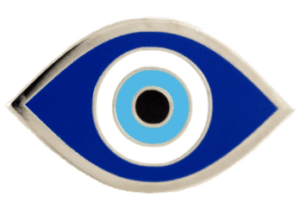

In the end, the eye represents consciousness
The eye is consciousness for very simple reasons and when we understand why the eye symbolizes consciousness, it becomes easy to see why the eye also symbolizes the rest.
Consciousness is basically “experiencing”. We experience the world with the help of our 5 senses, and of them, vision is arguably the most valued one. The eyes are also the most living-like sensory organs; they point to where we focus, they show our emotions and thoughts…
We, humans subconsciously read the eyes of those we communicate with. Eyes show emotions, motives, and sincerity. Dilating pupils are a sign of emotional arousal which makes the person seem more trustworthy, whereas a constricting pupil, being a sign of fear, makes the person seem less trustworthy.
The eyes don’t lie… unless you’re an emotionless psychopath, but even then, studies show that psychopaths tend to stare for a longer period of time.
The eyes mimic consciousness itself. It’s not in vain that we say that the eyes are the window of the soul.
The eye is the ambassador of the being. When addressing a person, you don’t look at their hair, or their nose, but their eyes. Just like the eye of God represents God himself, the eyes are the representation of you. The eye is the bindi or the core of the being we communicate with.
To Carl Jung, the eye is a living mandala
A mandala is an artistic configuration of the cosmos; the cosmos of the self, or the self of the cosmos. It is rich with symbolism and could also depict a metaphorical journey to enlightenment.
Mandala means circle in Sanskrit. The circle is symbolic of a whole, and inside of the whole is the core or the bindi, from which expanded the whole, and from which the two opposite forces are born.
Do you remember the creation myth where Pangu divided the yin from the yang? Check out the Yin Yang video if you don’t.
Opposites belong to the whole. They make the whole. Mandalas are used by monks for spiritual growth. Carl Jung used mandalas to help his patients bring chaos into order via their dreams.
The eyeball, with its pupil and iris, is like the mandala configuration. The eye represents the inside world, but it also observes the outside world. The eye, therefore, represents the cosmos that is conscious, as it observes.
Seeing someone confirms their existence, but being seen by someone also confirms our own. Being seen increases our self-awareness, let alone engaging in eye contact.
The eye observes and can’t help but judge. Being watched and judged has been one of humans’ most basic fears. It’s no wonder that a symbol of an eye would instil fear.
A study has shown that people acted more altruistically if they were exposed to an artificial eye on a computer screen.
To observe, the eye requires light
It is light that allows the eye to discriminate between all the colours of the world, and therefore images. God has been equated to light for millennia. Lately and arguably, so has consciousness.
One can entertain that:
God = Light = Consciousness
As light allows colours to exist, consciousness allows the colours of the mind to exist, or the concepts of the mind to exist; the good, the bad and all that is in between.
The cosmos of the eye observes the duality of the world but also bears it within it. There is a feedback loop between the two worlds – or perhaps these two worlds are just one and the same.
For as long as consciousness exists, opposing forces will as well. The eye may be that of the watchful good, or that of the ill-wishing evil. That’s why the iconography of the eye can rouse two different emotions; one of trust and one of distrust.
It is who is behind the eye, or associated with it, that will bring meaning to the eye.



